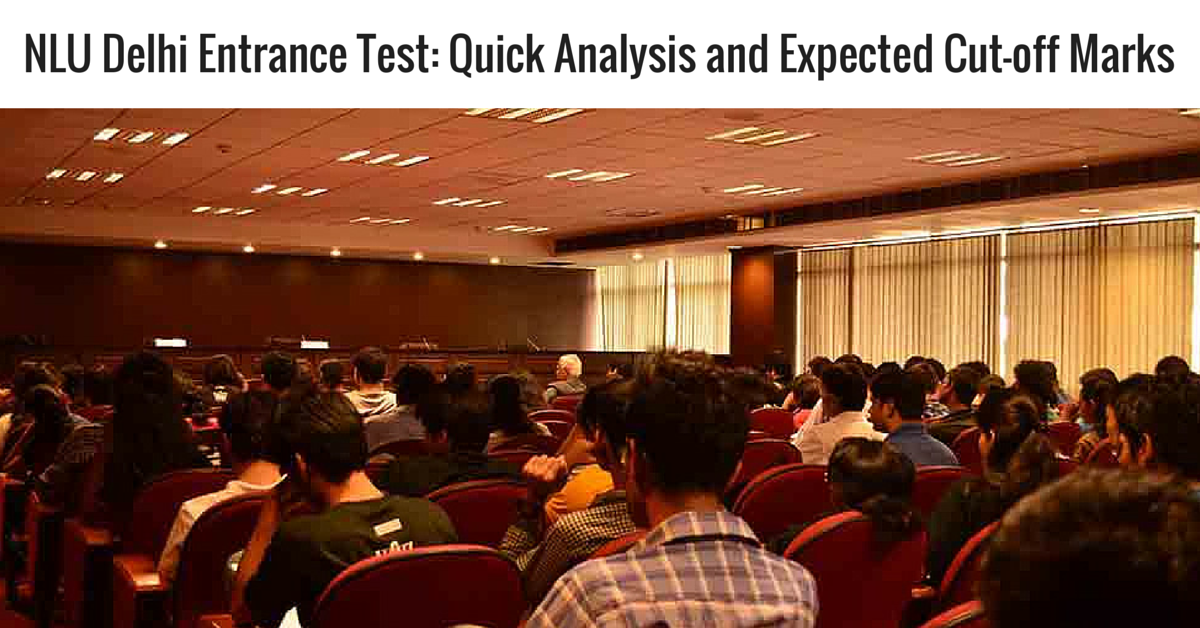Reasoning heavy. That is how one can describe today’s NLU Delhi paper. Student reaction has been mixed – and this is a paper in which cut off will be difficult to guess. It was not as lengthy as last years, but most students faced a time crunch. All over difficulty level was rationalised compared to last year, clearly NLU-D is experimenting in search of a better mix of questions that test reasoning ability and aptitude of students.
I would advise those who wrote the test today to treat it as a warm up for CLAT. A bigger arena awaits you next week. If your exam went perfect, as you planned, nothing like it. Identify the mistakes and deficiency that led you astray otherwise. Know what needs to be done, do it, and feel confident about CLAT.
Here is a quick analysis of the paper (and my views on CLAT in comparison to this paper).
- Legal Aptitude: As I had warned in the CLAT booster workshop, Legal Aptitude contained only legal reasoning. Some legal GK was found in the 20 marks GK section, but many were surprised by the relative disappearance of legal GK. If you listened to me, you would not be.
I am Not expecting CLAT to be full of legal GK either. GK is crucial given the CLAT structure, but the bedrock is reasoning. Legal reasoning should make a comeback, and be prepared to see new types of legal reasoning questions. The usual Principle-Fact-Options pattern is strongly expected, but a 2008 style introduction of new type reasoning is not out of the question. This has three important implications:
a. you must not panic if you see new types of questions in legal aptitude. It’s just like another logical reasoning section, based on legal principles. For instance, in 2008 some simple syllogism questions with legal principles were asked in Legal Aptitude. A lot of people didn’t even attempt these questions in fear, but those who solved them in the cool head found it very easy and scored 10 out of 10.
b. Go easy on legal GK. Stop reading cases and mugging up sections from statutes. I freak out when a student asks me what cases should they read. You are not expected to read cases. At best, know a little about the famous constitutional law cases like Keshavananda Bharati v. State of Kerala, Maneka Gandhi v Union of India etc – but then all you need to know is a one line description, not details. More important is to know some very basic information about the cases which have been in the news. Like the Best Bakery Case. Or a very famous case like Shah Bano or Unnikrishnan (introduced the right to education). Even this is too much to expect from a law aspirant – but many times these questions have come under GK so it makes sense to prepare a little for these cases. But from now on, stop trying to mug up more and more legal GK. You have done the basics, you are covered.
c. Focus on reasoning. Try to give more time to the reasoning section in the paper. If you are unclear about basics of legal reasoning, go back and read your BRMs/modules etc. You must not miss legal reasoning questions; with a little effort you can score full marks in that section. More reasoning also means lengthier paper, so watch out. Time management will be a huge factor again, unlike last year.
GK: GK section was simple. Relatively easy questions, mostly from current affairs. Typical questions like who won the Nobel peace prize, current president of South Africa didn’t leave many people stumped. I expect a similar GK portion for CLAT as well. If you have been preparing for GK systematically, reading newspaper and magazines regularly, there is little you need to worry about. You should focus on books like Pearson at this stage. If you have not started with it, or clueless about which part to start with check this out for a solution.
English: relatively easy. Reading comprehension had 5 questions. Reading speed could have made a difference, even generally in the paper, as a lot of reading and data assimilation was required. One of the more scoring sections in the paper. - Logical reasoning: this was the most important part in the paper. Clearly those who will do well here will make the final cut. However, this would be a little uncertain section as it was full of critical reasoning questions. Many interesting variations of the same were put into the paper. Even the brightest students generally cannot be very sure about critical reasoning questions, and I think this is going to bring the cut-off down a bit.
- Maths: Easy. Those who managed to keep their head cool in face of the time crunch did well in these 10 questions as well. I expect an easy maths section in CLAT too, those who are scared of maths, please solve the easy questions at least. And don’t leave Maths or logical reasoning for the end! That’s a perfect recipe for disaster.
EXPECTED CUT- OFF: With easy English, Maths and GK section, the Cutoff should definitely be higher than last year’s which was around 80. However due to the presence of a lot of critical reasoning and tricky legal reasoning questions, I don’t see the cut off going much above 100. If you have scored in excess of 105, you can feel confident.
 Serato DJ Crack 2025Serato DJ PRO Crack
Serato DJ Crack 2025Serato DJ PRO Crack









 Allow notifications
Allow notifications



